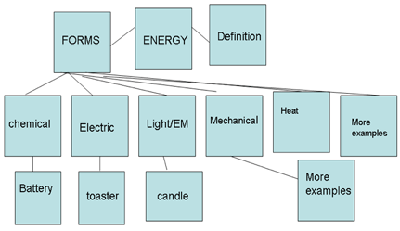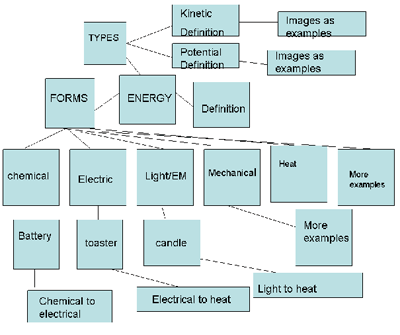
Background
Lesson
Home > Archive > For teachers > Energy (Physics) > Lesson
![]()
Students study various forms of energy and explore the transformation of energy from one form into another. Activities include an online interactive study of how kinetic and potential energy forms are associated with motion and height, respectively. Students then utilize SpicyNodes to organize information and make new connections among the concepts presented.
![]()
The students will be able to:
- Classify various forms of energy and explore how they are connected.
- Compare the kinetic and potential forms of energy manifestation.
- Explain how each form of energy is associated with a physical characteristic, such as temperature or physical state.
- Explain how electromagnetic energy travels in waves and light is electromagnetic energy.
- Recognize the real-world connections to the lesson.
Level: Grades 6-7
![]()
Household batteries, candles, sun, radio, thermometers, toy cars, pinwheel, Slinky, electric toaster. Pictures of all of the above items, and of nuclear power plans, free falling objects, windmills, and turbines. Another set of pictures of cell phones, microwave ovens, and hand-held devices.
Time needed: 4 hours (minimum)
![]()
Initially, groups of three or four students work in teams. While working with SpicyNodes, students can use individual computers. All of the activities, including the demonstrations, can be done in a computer lab.
![]()
![]()
- Introduce the concept of energy by starting with the energy from the Sun (solar).
- Divide the students into groups of four, and ask them to predict the possible forms of energy associated with the following demonstrations.
- Demonstrate the following items one after the other: household batteries, candles, sun, radio, thermometers, toy cars, Slinky, pinwheel, and falling object.
- Ask students to use SpicyNodes to write down their individual definitions of energy.
- Ask students to create SpicyNodes by using pictures demonstrating forms of energy. Students will identify various forms of energy associated with each picture. For example, for a Slinky, students will identify that the stretching and contraction of the Slinky is associated with elastic energy.
SpicyNodes Learning Activity Instructions:
- Ask students to start with the home node and create the label ENERGY.
- Question prompts for students to work with nodes:
- How do you define energy? Please open up the label, and enter your definition.
- What are the various forms of energy? Create new nodes.
- Which form of energy is associated with each picture? Create nodes and label them. Upload the pictures into the nodes. How will you make the connections using the nodes?
- Ask students to save their files. Students can use the same files to continue their exploration of the concept after completing activity 2.
![]()

Multidisciplinary Connections
Language Arts: Students can explore the origin of the word, “Energy.”
History of Science: Start learning about the history of energy usage. Start making a timeline with the inventions of various types of machinery, such as the sewing machine and steam engine. The nonlinear, open-ended and interactive format provided by the SpicyNodes presents a great opportunity to students to to create and develop the time line.
![]()
- Demonstrate to the class how an electric toaster works.
- Introduce the idea of energy conversion and ask students to come up with examples of energy conversion in their daily lives.
- Ask students to go to their nodemaps and use that knowledge to connect the nodes representing various energy forms by creating new nodes that identify sources of energy and trace its transformation. For example, link the picture of the toaster to electricity and heat with a new node (connecting electricity to heat).
- Ask students to open their SpicyNodes files.
- Questions and tips for creating new nodes:
- What are the forms of energy conversion involved with each picture you uploaded in Activity 1? (Example: electric toaster converts electric energy to heat.)
- Create a new node, and enter the forms of energy conversion involved. Then, connect that node to the node containing the picture.
- Do you have more examples from daily life? Create new nodes that include the energy conversions involved.
- Ask students to save their files. They will use them in Activity 3 to create nodes of energy forms.
![]()

Multidisciplinary Connections
History of Science:- Continue learning about the history of energy usage. Study the historical events around the period of the Industrial Revolution.
- Study the scientists and inventors connected to the discovery of various energy forms. Use SpicyNodes to connect their names.
World History: Study the events connected to imperialism and Britain’s Industrial revolution, starting with the factors that led to the Industrial Revolution.
![]()
![]()
- Download the “Energy in a Roller Coaster Ride” activity from the teacher’s domain site.
- Introduce the concept of potential energy and kinetic energy as two types of energy. Demonstrate the activity to the class. The activity can be best demonstrated using the STEP mode.
- Ask the student groups to report the kinetic and potential energy conversions in the activity, focusing on how the velocity of the roller coaster changes with its motion, and carefully noting the height of the roller coaster and velocity at each step. Students can make a table recording their observations and conclusions.
![]()
| Step # | Step Height (cm) | Kinetic Energy (as fraction) | Potential Energy (as fraction) | Velocity of the Roller Coaster (m/sec) |
|---|---|---|---|---|
SpicyNodes Learning Activity Instructions:
- Ask students to open their nodemaps.
- Questions and tips:
- Review your work on the forms of energy. Where would the “types of energy” go?
- What is kinetic energy?
- What is potential energy?
- Provide the following pictures: woman with a baseball bat, woman hitting the ball, apple on a tree, falling apple, rock at the top of a cliff, rock rolling on the cliff, diver standing ready to dive, and diver midway in the air. Ask the students to upload the pictures into their nodemaps, classifying them as potential and kinetic energy types).
![]()

Multidisciplinary Connections
Language Arts: Meaning of terms: kinetic, potential and gravitational
History of Science: Continue the work started with Activity 2
World History: Continue exploring Britain’s imperialism and its connection to the Industrial Revolution. For example, explore changes in Britain due to colonization and the Industrial Revolution.
![]()
- Introduce the concept of electromagnetic energy to the students. The following NASA web site is appropriate for middle school students site: Nasa’s electromagnetic spectrum. The web site helps students to recognize how light energy is connected with the frequency of the electromagnetic spectrum.
- Use a prism and a light source to demonstrate the light spectrum.
SpicyNodes Activity Instructions:
- Ask students to open their nodemaps.
- Questions and tips:
- Review the file. Where would you place electromagnetic energy?
- How is the electromagnetic spectrum divided? Name the parts of the spectrum.
- Name some appliances and gadgets that use electromagnetic waves.
- Upload the pictures or name the gadgets and appliances, and connect them to the parts of the electromagnetic spectrum.
![]()

Multidisciplinary Connections
History: Complete the timeline of invention of the machines and gadgets
History of Science: Complete or continue the study of events, inventors, and scientists related to the topic.
Environment: Explore renewable and nonrenewable forms of energy and their connection to the energy crisis. Questions can be initiated at the individual level, such as how their families are coping with gas and food price increases; choosing to switch to digital television in 2009; and how they dispose of household batteries, cell phones, and appliances. This topic can become the preview of a lesson or series of lessons on energy sources.
![]()
- Divide the class into groups of 3-4 students per group. Each group will have the following choices for examples: activity, appliance, natural occurrence/nature, electronic device, a method of transportation, favorite sports, etc.
- Students will create SpicyNodes that identify the example forms of energy, types of energy and track how energy changes from one form to another and one type (potential and kinetic) to another.
- Once the class completes the activity, students will make group presentations.
Home node: Where did the energy go? Click here to start.
- Activity - Type of energy, forms of energy, energy conversions
- Appliance - Type of energy, forms of energy, energy conversions
- Machine - Type of energy, forms of energy, energy conversions
- Method of transportation - Type of energy, forms of energy, energy conversions
- Favorite sports - Type of energy, forms of energy, energy conversions
Students will link all these nodes together making a giant node map and email the SpicyNodes URL (web site address) to their families, post the URL on their class or school web site.
![]()
Challenge: Once the students complete Activity 1, ask them to look at the conversions and see if they are reversible. For example, can you convert heat into electricity? Once students complete Activity 2, they can explore the connection between heat energy and temperature by visiting site: Classzone’s page on kinetic theory. Students can use SpicyNodes to organize the information.
Activity 4 variation: Students can create spectra using prisms and light sources in a laboratory. The following site can also be used to demonstrate kinetic, potential, and elastic energy forms: "Potential and Kinetic Energy: Spool Racer"
Math connections: Activity 4 demonstrates kinetic and potential energy in pie charts. This provides a good opportunity to review fractions and pie charts.
![]()
Teachers can use the students’ printouts of SpicyNodes for assessment. The rubric can be based on accuracy, completeness (adequate number of nodes), meaningful connections, new insights not covered in the class, and so forth.


